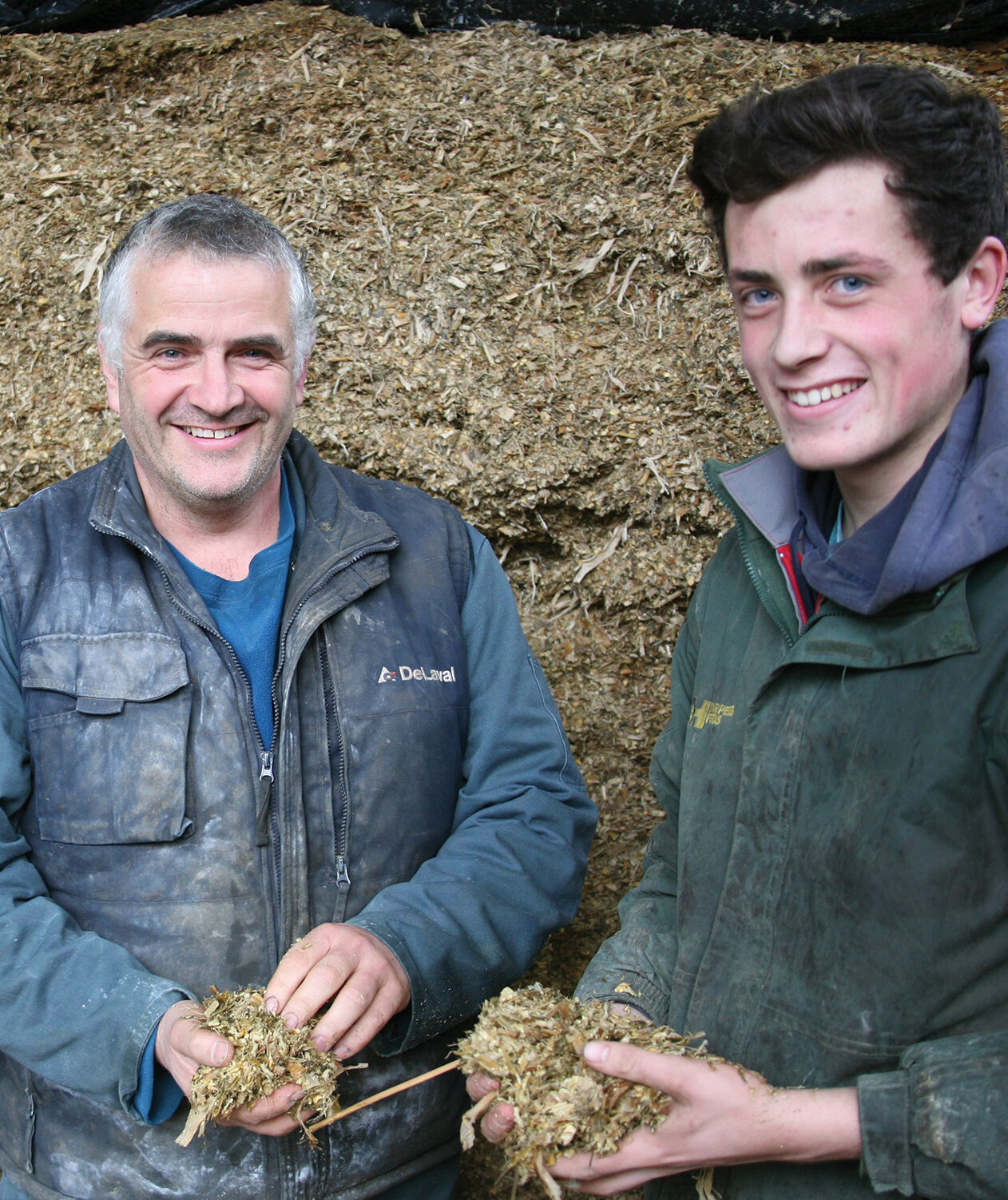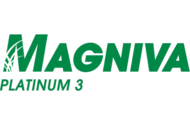
Jack Daniel
Dairy producer
“Our focus is on making the best quality silages we can as the basis for the ration. We also want to ensure that we feed as much as possible of the crop that goes into the clamp. MAGNIVA is keeping the clamp really cool, ensuring more of the energy gets into the cows.”
Name: Daniel family, Lower Rillaton Farm
Location: Callington in Cornwall, UK
Size: 160 dairy cows
Inoculant: MAGNIVA Platinum
Inoculants help drive forage efficiency
When your system is geared to turning home produced feeds into milk, forage efficiency is a key business objective. For the Daniel family from Lower Rillaton Farm, near Callington in Cornwall, ensuring effective fermentation and good stability is the foundation of their silage making. Jack Daniel runs the 350 acre farm with his father, Chris, and his sons, Matthew and Alex. The farm is home to 160 year-round calving cows averaging 8000 litres at 4.68% fat and 3.69% protein and the cropping is geared to feeding the stock on the farm. The cows are housed at night all year and graze by day in the summer. In addition to 230 acres of a mix of permanent pasture and grass reseeds, there are 30 acres of maize, 30 acres of wheat and 60 acres of barley, which is fed with a 25% double-mineralised protein concentrate. Diets are developed with Matt Dymond from Harpers Feeds and the cows are currently on 25kg grass silage, 10kg maize silage, 2.5kg treated wheat, 2kg of a soya/rape blend, straw, minerals and 5kg of bought-in fodder beet. This TMR gives M+16 litres with the barley/protein mix fed to yield through the parlour.Waste pushes up costs
“Our focus is on making the best quality silages we can as the basis for the ration,” Jack explains. “We also want to ensure that we feed as much as possible of the crop that goes into the clamp. Waste is just a drain on the business, pushing up costs.” Around 140 acres of first cut were taken in mid-May as they like a bit more fibre in first cut. Second cut of 110 acres was taken in late June with third and fourth cuts being baled. The family cut and rake the grass, before a contractor chops and clamps it. Chris Daniel rolls the clamp alongside the buck rake as they want good consolidation. First cut analysed at 27% DM and 11.8MJ ME/kg DM while second cut came in at 32% DM and 11.1MJ ME/kg DM. “Feeding grass all year round, we are after a rapid fermentation and a stable product as it takes us a week to get across the face in the summer and the clamps are outdoors and exposed to the elements.” This year they will move to the new MAGNIVA range of inoculants for grass Maize has been a central part of the system for many years and was drilled in mid-April under plastic. It was harvested in early October and treated with the new MAGNIVA Platinum inoculant.Less heating
MAGNIVA Platinum contains a unique combination of bacteria, L. buchneri and L. hilgardii, which quickly produce a number of antifungal compounds that significantly reduce the yeasts and moulds that cause heating, improving immediate aerobic stability, meaning clamps can be opened safely much sooner. They also improve longer term aerobic stability, protecting the silage while the clamp is open. By significantly reducing the populations of both yeasts and moulds, the antifungal compounds produced by the MAGNIVA inoculants reduce the main cause of the clamp heating and energy loss as well as reduced silage palatability. “Stability is really important for us,” Jack continues. “It takes us 4-5 days to work across the face and we don’t want to see the silage heating as this is just wasting energy and increasing our costs. We had concerns this year as we had a wet September and there were signs of Fusarium, which might have caused the clamp to heat up.” Steve Symons from Lallemand Animal Nutrition recently took infrared photographs of the clamp, and they show no signs of heating across the face. “MAGNIVA is keeping the clamp really cool, ensuring more of the energy gets into the cows. Temperature readings taken show the temperature eight inches behind the face was also consistent, a sure sign of excellent aerobic stability.”
Purpan Engineering School
Educational institution
“From now on, we intend to treat our grass and wholecrop mix silage with MAGNIVA Platinum to guarantee a high quality silage that our cows and heifers can use.”
Farm: Purpan Engineering School
Location, Year: Domaine de Lamothe, Seysses, France
Farm Size: 229ha, 105 dairy cows
Inoculant used: MAGNIVA Platinum ((L. hilgardii CNCM I-4785 and L. buchneri NCIMB 40788)
“We increased the forage diversity grown on farm and optimised our silo storage areas by improving the preservation quality in silo.” Cultivation: 229 ha including 50 ha of completely irrigated maize for silage, 16 ha of wholecrop mix silage (oat, pea, vetch, and triticale), 15 ha of alfalfa hay, 10 ha of corn grain, 6 ha of grassland for hay for 105 dairy cows (DC) producing 31 or 32 kg Workforce: 4 people Ration: DC: Maize silage/grass silage/alfalfa hay/soya/corn grain/ DC 3 l structure and 70/30/mineral mix with LEVUCELL SC Biogas activity: Micromethanation (prototype) + teaching activity (welcoming student engineers and trials for scientific publications by the teacher-researchers at the Purpan school) Objectives: To increase interaction with the public and training organizations Do you treat your grass and maize silos? If so, please indicate the quantity produced and treated/year- Previously no inoculants were used
- In 2020, 550 tons of maize at 36% DM was produced and stored in 1 silo. Yield was 18 tonnes DM/ha
What type of silage additive do you use?
Trial carried out with a MAGNIVA Platinum 1 silage inoculant.What were the reasons for this choice? Who recommended them to you?
- They were suggested to us by the Lallemand team with whom we have previously carried out both trial and training with other products with the teaching and student teams.
- In 2019, the silos were renovated, and we needed a little more flexibility with the silo to open and utilise silage earlier than normal, within 15-20 days with a rapid opening for one of the maize silos.
- We regularly carry out nutritional trials on the herd and did not fully understand that the nutritional quality of silage can change after opening if not stable. With this, we realized we ran the risk of falsifying our trial results.
- The maize harvested in 2018 had very high dry matter and the stability in the silo was poor. This resulted in silage losses and poor animal performance.
- Finally, Lallemand made us aware of the fact that we were regularly in contact with the public and that the treatment of silage (to limit the physical and nutritional losses of our silages) was fully compatible with our approach towards limiting the carbon footprint of our operation Producing more milk with the smallest possible land area and enhancing the nutritional value of our silage to limit the purchase and transport of raw materials by road (or on boats for soya).
Have you noticed an effect on the visible losses? (e.g. due to mould)
- On a full silo of 550 tons, we only had to sort the equivalent of 2 barrow loads.
- We returned 198 tons of DM (or 192,000 Feed Units for Lactation (FUL), to the silo and tried to enhance the value as much as possible and to transform these FUL into milk (5% acceptable loss but no more because maize is expensive to produce)
Has the reduced/eliminated need to sort moldy parts resulted in any time-saving?
- Emptying now only takes us about 30 minutes per week.
- We used to have to sort manually before emptying the silo to ensure the distribution of a visibly healthy silage
- The silage did not turn orangey-yellow like normal and kept its initial color.
What have been the main benefits you have seen since using MAGNIVA Platinum?
- As a result of the minimum losses observed in our silos, we can now fine-tune our crop rotation so as not to attribute excessively large areas of land to the animals.
- If we free up some areas, we will certainly have a little more silage used in the biogas plant.
- It should be pointed out that, for years, we had to purchase silage from outside to feed our animals. This is no longer the case.
Since using MAGNIVA Platinum, have you noticed any benefits, such as improved palatability, nutritional and energy values?
- We have noticed much less silage left in the trough, less sorting even under the conditions in September and October when the ambient temperature was still rather high in our region. Also, after distributing the silage, we noticed it cooled rapidly (although the residual heat that we had measured since the ensiling day remained high for 4 months).
- We carried out some aerobic stability tests (period in which the silage remains at a temperature of less than 2 degrees above ambient temperature) and the silage removed from the silo took 4 days before warming up and thus deteriorating.
- Some nutritional and microbiological tests were carried out from the day of harvesting and every month until the end of ensiling and the FU, DM, Nt and ingestion values remained at a very high level (0.97 FUL). The cows had a constant supply of energy throughout the feedout duration (a rich, palatable silage is the key to success).
- Even though, upon harvesting, our silage presented a very large fermentation challenge due to high levels of yeasts being detected.
- However, on opening, the silage was of high quality and no spoilage, wastage or heating was apparent.
- Our cows did not suffer any health problems (good cellular levels, regular ingestion and milk produced in large quantities).
- This naturally led to high performance levels during a year in which our number of dairy cows was relatively limited.
Have you noticed an effect on your milk production (quantity and quality) and animal health?
We already used Lallemand live yeasts to try to obtain the highest possible nutritional value and degree of gastrointestinal and immunological safety. Throughout the use of the silo, the performance levels were very high: 32 kg of milk on average and high fat content (41.5 to 42) and, above all, 34 of protein content (with a record for us of 35.5 in November). The cow pats were more regular than usual and the cellular levels were normal.What are the main daily benefits from using your treated silage?
- It is extremely important for us not to waste time sorting the silage and removing any fodder left by the cows. We opened the silo for the first time, 20 days after ensiling, and the herd did not suffer any negative consequences (the silo was already stabilized (pH<4). More importantly, the silage cooled quickly after removing from the silo. Retained heat in the silo was 19 degrees higher than ambient, which was the temperature of the maize upon ensiling as measured by temperature sensors integrated in the silo.
- From now on, we intend to treat our grass and wholecrop mix silage with MAGNIVA Platinum to guarantee a high quality silage that our cows and heifers can use to the full, whatever the harvesting and DM conditions are like.
- For us, high quality silage represents a guarantee that the results of the tests carried out by the teaching and scientific teams will not distorted results in any way.
- The solution implemented by the contractor equipped in 2019 with a new Shredladge fodder harvester has been extremely successful (no shortage or remaining product upon completion of the work). For this, he used the new Lallemand mobile application to regulate his machine.
How did you, together with Lallemand, assess your silo making practices and aerobic stability of your silage uponopening the silo?
Firstly, a complete audit of the silo was performed every month until the end of fermentation. Then , two stability tests in polystyrene boxes to measure how long it took for the silage temperature to change (4 days to see the silage temperature change: measured using sensors inside the boxes).
Vander Groef
Dairy producer
“With stable forages, we don’t get heating in the feed bunk — especially in the summer months.”









